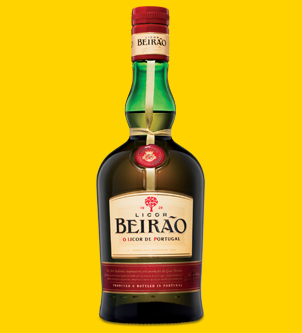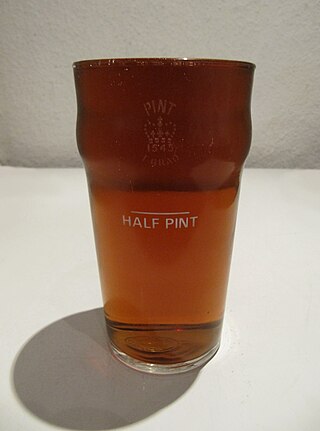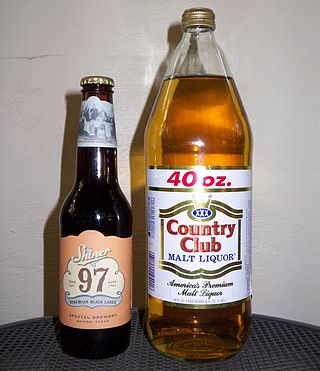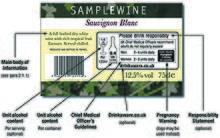
An alcopop is any of certain mixed alcoholic beverages with relatively low alcohol content, including:
- Malt beverages to which various fruit juices or other flavorings have been added
- Wine coolers: beverages containing wine to which ingredients such as fruit juice or other flavorings have been added
- Mixed drinks containing distilled alcohol and sweet liquids such as fruit juices or other flavourings

Beer is one of the oldest types of alcoholic drinks in the world, and the most widely consumed. It is the third most popular drink overall after potable water and tea. It is produced by the brewing and fermentation of starches, mainly derived from cereal grains—most commonly malted barley, though wheat, maize (corn), rice, and oats are also used. During the brewing process, fermentation of the starch sugars in the wort produces ethanol and carbonation in the resulting beer. Most modern beer is brewed with hops, which add bitterness and other flavours and act as a natural preservative and stabilising agent. Other flavouring agents such as gruit, herbs, or fruits may be included or used instead of hops. In commercial brewing, the natural carbonation effect is often removed during processing and replaced with forced carbonation.

Gin is a distilled alcoholic drink that derives its flavour from juniper berries and other botanical ingredients.

A liqueur is an alcoholic drink composed of spirits and additional flavorings such as sugar, fruits, herbs, and spices. Often served with or after dessert, they are typically heavily sweetened and un-aged beyond a resting period during production, when necessary, for their flavors to mingle.

Low-alcohol beer is beer with little or no alcohol content that aims to reproduce the taste of beer while eliminating or reducing the inebriating effect, carbohydrates, and calories of regular alcoholic brews. Low-alcohol beers can come in different beer styles such as lagers, stouts, and ales. Low-alcohol beer is also known as light beer, non-alcoholic beer, small beer, small ale, or near-beer.

Alcohol proof is a measure of the content of ethanol (alcohol) in an alcoholic beverage. The term was originally used in England and from 1816 was equal to about 1.75 times the percentage of alcohol by volume (ABV). The United Kingdom today uses ABV instead of proof. In the United States, alcohol proof is defined as twice the percentage of ABV. The definition of proof in terms of ABV varies from country to country.

The pint is a unit of volume or capacity in both the imperial and United States customary measurement systems. In both of those systems it is traditionally one eighth of a gallon. The British imperial pint is about 20% larger than the American pint because the two systems are defined differently. Almost all other countries have standardized on the metric system, so although some of them still also have traditional units called pints, the volume varies by regional custom.

Alcohol by volume is a standard measure of how much alcohol (ethanol) is contained in a given volume of an alcoholic beverage. It is defined as the number of millilitres (mL) of pure ethanol present in 100 mL of solution at 20 °C (68 °F). The number of millilitres of pure ethanol is the mass of the ethanol divided by its density at 20 °C (68 °F), which is 0.78945 g/mL. The alc/vol standard is used worldwide. The International Organization of Legal Metrology has tables of density of water–ethanol mixtures at different concentrations and temperatures.

Malt liquor is a type of mass market beer with high alcohol content, most closely associated with North America. Legally, it often includes any alcoholic beverage with 5% or more alcohol by volume made with malted barley. In common usage, it refers to beers containing a high alcohol content, generally above 6%, which are made with ingredients and processes resembling those for American-style lagers.

Liquor is an alcoholic drink produced by the distillation of grains, fruits, vegetables, or sugar that have already gone through alcoholic fermentation. Other terms for liquor include: spirit, distilled beverage, spirituous liquor or hard liquor. The distillation process concentrates the liquid to increase its alcohol by volume. As liquors contain significantly more alcohol (ethanol) than other alcoholic drinks, they are considered "harder." In North America, the term hard liquor is sometimes used to distinguish distilled alcoholic drinks from non-distilled ones, whereas the term spirits is more commonly used in the UK. Some examples of liquors include vodka, rum, gin, and tequila. Liquors are often aged in barrels, such as for the production of brandy and whiskey, or are infused with flavorings to form flavored liquors, such as absinthe.

Beer is a major part of German culture. Only water, hops, and malt are permitted as ingredients, and beers not exclusively using barley-malt, such as wheat beer, must be top-fermented.

A pint glass is a form of drinkware made to hold either a British imperial pint of 20 imperial fluid ounces (568 ml) or an American pint of 16 US fluid ounces (473 ml). Other definitions also exist, see below. These glasses are typically used to serve beer, and also often for cider.
Rectified spirit, also known as neutral spirits, rectified alcohol or ethyl alcohol of agricultural origin, is highly concentrated ethanol that has been purified by means of repeated distillation in a process called rectification. In some countries, denatured alcohol or denatured rectified spirit may commonly be available as "rectified spirit", because in some countries the retail of rectified alcohol in its non-denatured form is prohibited.

Various unique terminology is used in bartending.
Alcohol measurements are units of measurement for determining amounts of beverage alcohol.

Beer glassware comprise vessels made of glass, designed or commonly used for serving and drinking beer. Styles of glassware vary in accord with national or regional traditions; legal or customary requirements regarding serving measures and fill lines; such practicalities as breakage avoidance in washing, stacking or storage; commercial promotion by breweries; artistic or cultural expression in folk art or as novelty items or usage in drinking games; or to complement, to enhance, or to otherwise affect a particular type of beer's temperature, appearance and aroma, as in the case of its head. Drinking vessels intended for beer are made from a variety of materials other than glass, including pottery, pewter, and wood.
An alcohol-free or non-alcoholic drink, also known as a temperance drink, is a version of an alcoholic drink made without alcohol, or with the alcohol removed or reduced to almost zero. These may take the form of a non-alcoholic mixed drink or non-alcoholic beer, and are widely available where alcoholic drinks are sold.

An alcoholic beverage is a drink that contains ethanol, a type of alcohol and is produced by fermentation of grains, fruits, or other sources of sugar. The consumption of alcoholic drinks, often referred to as "drinking", plays an important social role in many cultures. Alcoholic drinks are typically divided into three classes—beers, wines, and spirits—and typically their alcohol content is between 3% and 50%.

A fifth is a unit of volume formerly used for wine and distilled beverages in the United States, equal to one fifth of a US liquid gallon, or 25+3⁄5 U.S. fluid ounces ; it has been superseded by the metric bottle size of 750 ml, sometimes called a metric fifth, which is the standard capacity of wine bottles worldwide and is approximately 1% smaller.
A number of units of measurement were used in South Africa to measure quantities like length, mass, capacity, etc. The Imperial system of measurements was made standard in 1922 and the metric system was adopted in 1970.

























